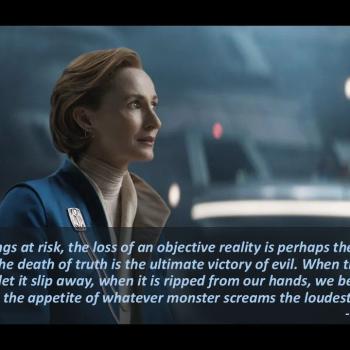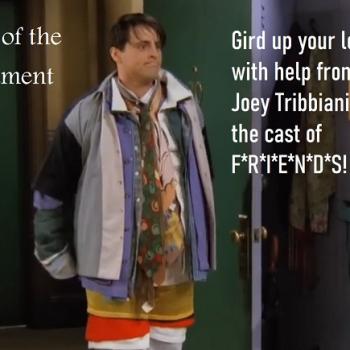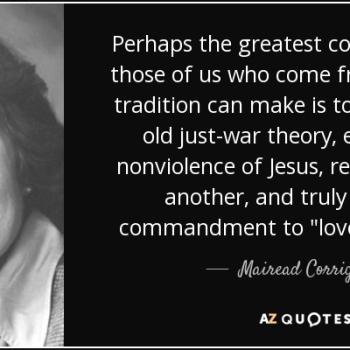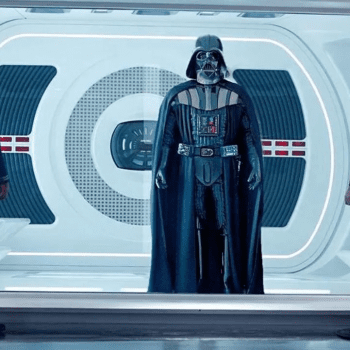As I said in my review of The Rise of Skywalker, I’ve long seen the outlook of the Star Wars as being about balance, a Taoist vision of light and dark, calm and anger, passivity and exertion, rather than a Zoroastrian one, as it were. I’ve also long said that a major focus is redemption of enemies rather than destroying them, as Luke Skywalker does with his father Anakin. And so I wondered how the Skywalker story would be brought to a conclusion, and whether J. J. Abrams and others would remain true to that legacy and trajectory.
It would be a spoiler to say whether I was happy with precisely what was done. But I can say that I was delighted to read Gareth Higgins’ treatment of the topic of the ethics of nonviolence as it relates to Star Wars in general and The Rise of Skywalker in particular. He wrote in Sojourners (with spoilers in what follows, I must now add, for those who have not seen the latest movie):
Now that we’ve had effectively three Death Stars/planet-killing machines — and every time you blow one up, the bad guys build another — can anything really matter? Can we even feel the unhealthy catharsis of watching more First Order/Empire hardware explode? Furthermore, when you “kill” two of your most beloved characters only to “resurrect” them a few minutes later, you’re playing games with the audience, and avoiding the possibility of saying something truthful about life in general, and the cost of resistance in particular. No harm would have been done to the Star Wars universe to leave these characters dead — indeed, it would have added gravity to a strangely weightless film.
Where there is some gravity, it is in Rey’s attempt to reconcile light and shadow within, and the realization that Ben is trying to do the same thing from the other direction. This may actually be the most valuable axis in the entire saga — the most useful, I mean, to those of us watching who realize that we’re all invited to the same struggle: Which path will we choose? Listening to the voices of mentors who want the best for us and for the common good — whether in person or a memory — really is a spiritual practice upon which may depend the fuller formation of human character. This apprenticeship to a higher way — call it Jedi, call it consciousness, call it finding an inner ally — leads me to realize after all these years that George Lucas probably knew more about what he was doing than he let on. All of us are called to a hero’s journey; whether that journey ends in tyranny or service will depend on whether we integrate the shadow. Rey and Ben’s dialogues with themselves and each other are, in this light, definitely a cut above what most blockbusters offer by way of personal development pep talks.
Again, it’s in the relationships that Star Wars always had the most potential. In Luke’s putting aside of childish things in favor of service, in Leia’s self-sacrifice for the sake of the many, in Anakin’s repentance, but now most especially, in Rey and Ben’s discovery of how to live with the burden of a toxic past without repeating it, this saga has some force.
Even more heartening, for those of us concerned with how to engage in less war, is that the manner of the Emperor’s demise exemplifies something other than “our team” using greater violence than theirs. Instead, our surrogates form an alliance of two, willing to spend their lives protecting the vulnerable. Let’s just say that their shield reflects quite badly on the Emperor, who turns his rage inward and literally dies by his own hands. Now that’s not exactly restorative justice, but as a confrontation of evil powers with the true damage of their efforts, it’s a lot better than dropping an atomic bomb on a civilian population. And it’s here where the movie is honest that putting your body between despotism and its targets is not without heavy costs. But while Rey and Ben are sacrificing for a better world, their friends above are shooting a lot of people. It takes imagination to figure out a creative solution to the violent imposition of the belief that some lives are worth more than others; it takes a willingness to do more than return an eye for an eye; it takes commitment to long-term thinking about people power and the common good. On one planet The Rise of Skywalker really does want to promote something better than the myth of redemptive violence, but in the sky it’s not so sure.
Click through to read the whole thing. I also felt very disappointed with myself for not having recognized Wadi Rum in Jordan, which I’ve visited, as the location where some of Rise of Skywalker was filmed. Then again, I apparently missed it in Rogue One as well…













